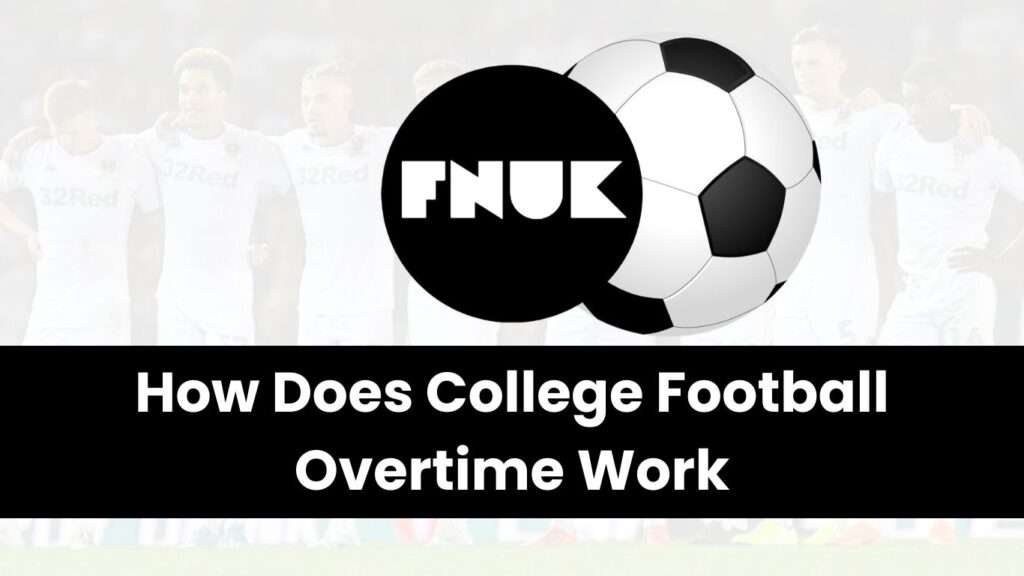College football is thrilling, and if you’ve watched it long enough, you know that overtime can push the excitement into overdrive.
But how does college football overtime work exactly?
This blog post will walk you through the basics and nuances of college football overtime, its impact on games, and why it’s such a vital part of the sport.
Understanding the Basics
The Rules that Govern Overtime in College Football
The rules for college football overtime are unique and different from other football leagues.
From the very beginning, both teams are given equal opportunities to score.
The coin toss determines who gets the ball first, and each team starts at the opponent’s 25-yard line.
The game continues until one team outscores the other in a completed overtime period. If the game is still tied, another overtime period begins.
Scoring and Gameplay
In each overtime period, teams have to score, whether by field goal or touchdown.
If both teams score the same number of points, the game moves to another overtime.
If one team scores more points than the other, they win.
The Role of the Coin Toss
The tone for the entire overtime can be set in the coin toss.
The team that wins the toss often elects to defend first.
This way they know what they need to do offensively when they eventually get the ball, and whether they need a field goal or a TD to win the game.
Analysis of Recent Changes
Updates to the Rules
In an effort to shorten the length of games and decrease the number of overtime periods, the rules have changed in recent times.
No longer will overtime last for however long it takes for one team to outscore the other.
Beginning with the second overtime, teams must go for a two-point conversion after a touchdown
Impact of Rule Changes
This can add a new bit of strategy to the game. Now, coaches have to think about their players being worn down and ready to play longer and work on more of the specific two-point plays that fit in their schemes.
Proposed Changes
There’s been much debate on the topic of tightening up college football overtime to make the extra periods safer and better to watch.
A potential change would be to moving the overtime periods up a few yards, allowing one series to start at the 15-yard line instead of the 25, making it more likely that something happens and shortening the games in the process.
Strategy and Play-by-Play
Defensive Strategies
Overtime defences lean toward playing for a takeaway or at least a field goal.
A lot of teams look for ways to get pressure on the quarterback and force quick decisions, by creating a stronger defensive front.
Offensive Strategies
Offensively, this usually means a good mix of running and passing so that the defence cannot predict.
In these situations, types of play you can consistently rely on, and your consistently reliable players are often counted on to make the difference.
Impact of Coaching Decisions
The impact of coaching on the extra session cannot be underlined enough.
Everything from positioning to putting the right athletes out on the field are decisions that can make or break the game in overtime.
Overtime Across Different Leagues
College Football vs. NFL Overtime
One of the key variations is the way in which possession is established in college football versus NFL overtime rules.
In the NFL, the team scoring the touchdown first wins and in college football, both have opps to do so
This fundamental difference gives rise to diverse strategic mechanisms.
High School Football Rules
High school level football has its own rules for overtime, which will vary depending on location.
Its format is highly similar to that of college football however both teams get going at the 10-yard line rather than the 25-yard line as it is in college football.
International Overtime Rules
While American football has an inherently smaller global footprint, other countries feature similar overtime rules in their leagues, tailored to that particular competition, but borrowing elements from both the NFL and college games.
The Impact on Games and Season Outcomes
Memorable Games Decided in Overtime
Over the years, there have been a variety of overtime games that stem college football folklore.
Remember the 2003 National Championship Game between Ohio State and Miami?
The final was decided in double overtime, where Ohio State claimed the title against Miami (OH).
Games like that are making instant fortunes, and its memories are saved for years.
Season Outcomes
The results of games that go into overtime can have a material effect on a team’s season.
The difference between playing in a bowl game or not can boil down to just one overtime loss.
On the other hand, an OT victory at the right time may propel a team to the postseason.
Fan Reactions
Fans eat up the drama and randomness of overtime football.
This elevated the tension and stakes to a whole new level, and as a result, the watching experience became more thrilling.
Tweets, comments and memes all over the social media hoods describe just how much drama rolls in those final seconds of overtime.
Conclusion
Is there a more exciting version of college football than its overtime?
Its the difference in rules and newer developments it offers has only added to the attraction and it has become an essential part of the sport.
All of these details can be appreciated whether you’re new to the sport or an aficionado, as they offer differing looks at football at large.
Overtime: The Ultimate Test of Skill and Endurance for Players and Coaches The most height ten the world for the fans.
Understanding the college football overtime rules will give you an advantage in following the game you love.



